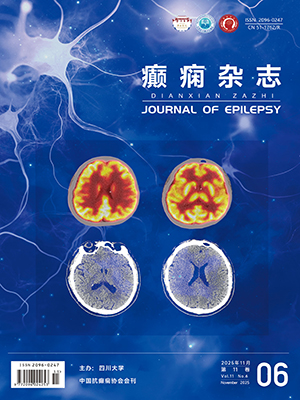| 1. |
Graus F, Titulaer MJ, Balu R, et al. A clinical approach to diagnosis of autoimmune encephalitis. The Lancet Neurology, 2016, 15(4): 391-404.
|
| 2. |
中華醫學會神經病學分會神經感染性疾病與腦脊液細胞學學組. 中國自身免疫性腦炎診治專家共識(2022年版). 中華神經科雜志, 2022, 55(9): 931-949.
|
| 3. |
Geis C, Planagumà J, Carre?o M, et al. Autoimmune seizures and epilepsy. The Journal of clinical investigation, 2019, 129(3): 926-940.
|
| 4. |
Titulaer MJ, McCracken L, Gabilondo I, et al. Treatment and prognostic factors for long-term outcome in patients with anti-NMDA receptor encephalitis: an observational cohort study. The Lancet Neurology, 2013, 12(2): 157-165.
|
| 5. |
Chi X, Wang W, Huang C, et al. Risk factors for mortality in patients with anti‐NMDA receptor encephalitis. Acta Neurologica Scandinavica, 2017, 136(4): 298-304.
|
| 6. |
Fisher RS, Acevedo C, Arzimanoglou A, et al. ILAE official report: a practical clinical definition of epilepsy. Epilepsia, 2014, 55(4): 475-482.
|
| 7. |
Liu F, Huang T, Wang B, et al. Low high-density lipoprotein cholesterol and apolipoprotein AI levels are associated with poor outcome and relapse in autoimmune encephalitis. Neuroscience Letters, 2022, 775: 136546.
|
| 8. |
Shen CH, Fang GL, Yang F, et al. Seizures and risk of epilepsy in anti‐NMDAR, anti‐LGI1, and anti‐GABABR encephalitis. Annals of Clinical and Translational Neurology, 2020, 7(8): 1392-1399.
|
| 9. |
Shu Y, Chen C, Chen Y, et al. Serum complement levels in anti‐N‐methyl‐d‐aspartate receptor encephalitis. European Journal of Neurology, 2018, 25(1): 178-184.
|
| 10. |
Qu X, Vidaurre J, Peng X, et al. Seizure characteristics, outcome, and risk of epilepsy in pediatric anti-N-methyl-D-aspartate receptor encephalitis. Pediatric Neurology, 2020, 105: 35-40.
|
| 11. |
Shi X, Cai W, Zhang X, et al. Early predictors of new-onset immune-related seizures: a preliminary study. BMC Neurology, 2022, 22(1): 503.
|
| 12. |
Zou C, Pei S, Yan W, et al. Cerebrospinal fluid Osteopontin and inflammation-associated cytokines in patients with anti-N-methyl-D-aspartate receptor encephalitis. Frontiers in Neurology, 2020, 11: 519692.
|
| 13. |
Zhong R, Chen Q, Li M, et al. Elevated blood C-reactive protein levels in patients with epilepsy: a systematic review and meta-analysis. Frontiers in Neurology, 2019, 10: 974.
|
| 14. |
Ishikawa N, Kobayashi Y, Fujii Y, et al. Increased interleukin-6 and high-sensitivity C-reactive protein levels in pediatric epilepsy patients with frequent, refractory generalized motor seizures. Seizure, 2015, 25: 136-140.
|
| 15. |
Ji S R, Zhang S H, Chang Y, et al. C-reactive protein: the most familiar stranger. The Journal of Immunology, 2023, 210(6): 699-707.
|
| 16. |
Shao W, Zhang S, Tang M, et al. Suppression of neuroinflammation by astrocytic dopamine D2 receptors via αB-crystallin. Nature, 2013, 494(7435): 90-94.
|
| 17. |
Barbierato M, Facci L, Argentini C, et al. Astrocyte-microglia cooperation in the expression of a pro-inflammatory phenotype. CNS & Neurological Disorders-Drug Targets (Formerly Current Drug Targets-CNS & Neurological Disorders), 2013, 12(5): 608-618.
|
| 18. |
Esse R, Barroso M, Tavares de Almeida I, et al. The contribution of homocysteine metabolism disruption to endothelial dysfunction: state-of-the-art. International journal of molecular sciences, 2019, 20(4): 867.
|
| 19. |
Moretti R, Giuffré M, Caruso P, et al. Homocysteine in neurology: a possible contributing factor to small vessel disease. International Journal of Molecular Sciences, 2021, 22(4): 2051.
|
| 20. |
Kamath A F, Chauhan A K, Kisucka J, et al. Elevated levels of homocysteine compromise blood-brain barrier integrity in mice. Blood, 2006, 107(2): 591-593.
|
| 21. |
Obeid R, Herrmann W. Mechanisms of homocysteine neurotoxicity in neurodegenerative diseases with special reference to dementia. FEBS letters, 2006, 580(13): 2994-3005.
|
| 22. |
Tao H, Gong Y, Yu Q, et al. Elevated serum matrix metalloproteinase-9, interleukin-6, hypersensitive C-reactive protein, and homocysteine levels in patients with epilepsy. Journal of Interferon & Cytokine Research, 2020, 40(3): 152-158.
|
| 23. |
Shakir S, Ali N, Udin Z, et al. Vitamin B6 and homocysteine levels in carbamazepine treated epilepsy of Khyber Pakhtunkhwa. African Health Sciences, 2017, 17(2): 559-565.
|
| 24. |
Fontes L P, Fontes M P, Jiménez P Q, et al. Comparative case-control study of homocysteine, vitamin B12, and folic acid levels in patients with epilepsy. Neurología (English Edition), 2017, 32(7): 440-445.
|
| 25. |
高慧, 顧燕, 華深, 等. 亞甲基四氫葉酸還原酶基因多態性與精神分裂癥伴抑郁的關系. 臨床精神醫學雜志, 2022, 32(3): 169-171.
|
| 26. |
Zou R, Dai Y, Wang D, et al. Association between MTHFR polymorphism and seizure control in epileptic patients with hyperhomocysteinaemia. Epileptic Disorders, 2022, 24(5): 889-897.
|
| 27. |
Chango A, De Courcy GP, Boisson F, et al. 5, 10-methylenetetrahydrofolate reductase common mutations, folate status and plasma homocysteine in healthy French adults of the Supplementation en Vitamines et Mineraux Antioxydants (SU. VI. MAX) cohort. British Journal of Nutrition, 2000, 84(6): 891-896.
|
| 28. |
Karatoprak E, Sozen G, Y?lmaz K, et al. Interictal epileptiform discharges on electroencephalography in children with methylenetetrahydrofolate reductase (MTHFR) polymorphisms. Neurological Sciences, 2020, 41: 631-636.
|
| 29. |
Kluijtmans LAJ, Young IS, Boreham CA, et al. Genetic and nutritional factors contributing to hyperhomocysteinemia in young adults. Blood, 2003, 101(7): 2483-2488.
|




